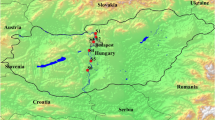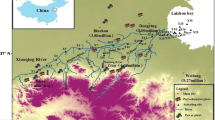Abstract
The main objective of this study was to investigate occurrence of polycyclic aromatic hydrocarbons (PAHs) in the sources of the drinking water supply of Hong Kong. The main emphasis was on the Dongjiang River in mainland China which is the major source, supplying 80% of the total consumption in Hong Kong (the remaining 20% is obtained from rain water). Sediments were collected from four sites along the Dongjiang River and four reservoirs in Hong Kong during both the dry and wet weather seasons. The concentrations of total PAHs in the sediments ranged between 36 and 539 μg/kg dry wt. The lower levels were detected at the upstream site on the Dongjiang River and at the reservoirs in Hong Kong (44–85 μg/kg dry wt), while the mid- and downstream sites on the Dongjiang River were more polluted (588–658 μg/kg dry wt). Examination of the PAH profiles revealed that the mid- and downstream sections of the Dongjiang River contained high percentages of 4,5,6-ring PAHs, similar to the amounts of atmospheric particulate matter and road dust collected during the dry weather season from the Pearl River Delta region as reported in the literature. Seasonal changes were revealed in the reservoirs of Hong Kong, with higher PAH levels in the wet weather season than in the dry weather season. For those reservoirs in Hong Kong that store water from the Dongjiang River, a distinct seasonal pattern was also observed, namely, that under dry weather season conditions the PAHs found in the sediments were primarily from petrogenic source, while under wet weather season conditions they were from pyrolytic sources. No such pattern was detected in the reservoirs which stored only rain water.
Similar content being viewed by others
References
Agency for Toxic Substances and Disease Registry (1995). Toxicological Profile for Polycyclic Aromatic Hydrocarbons. Atlanta, GA, USA: U.S. Department of Health and Human Services.
Basu, D. K., & Saxena, J. (1978). Polynuclear aromatic hydrocarbons in selected US drinking waters and their water sources. Environmental Science & Technology, 12, 795–798.
Bauer, J. E., & Capone, D. G. (1988). Effects of co-occurring aromatics hydrocarbons on degradation of individual polycyclic aromatic hydrocarbons in marine sediment slurries. Applied and Environmental Microbiology, 54, 1649–1655.
Budzinski, H., Jones, I., Bellocq, J., Piérard, C., & Garrigues, P. (1997). Evaluation of sediment contamination by polycyclic aromatic hydrocarbons in the Gironde estuary. Marine Chemistry, 58, 85–97.
Dahle, S., Savinov, V. M., Matishov, G. G., Evenset, A., & Nas, K. (2003). Polycyclic aromatic hydrocarbons (PAHs) in bottom sediments of the Kara Sea shelf, Gulf of Ob and Yenisei Bay. Science of the Total Environment, 306, 57–71.
Guo, H., Lee, S. C., Ho, K. F., Wang, X. M., & Zou, S. C. (2003). Particle-associated polycyclic aromatic hydrocarbons in urban air of Hong Kong. Atmospheric Environment, 37, 5307–5317.
Ho, K. F., Lee, S. C., & Chiu, G. M. Y. (2002). Characterization of selected volatile organic compounds, polycyclic aromatic hydrocarbons and carbonyl compounds at a roadside monitoring station. Atmospheric Environment, 36, 57–65.
Ho, K. C., & Yau, J. T. S. (2003). A comparative study of chemical contamination in sediments of East River (Dongjiang) and selected reservoirs in Hong Kong. Chemical Speciation and Bioavailability, 14, 19–23.
Hong Kong Water Supply Department (1996). Hong Kong’s water. Hong Kong, China: Hong Kong Water Supply Department.
Hong Kong Water Supply Department (1998). Dongshen-Hong Kong water supply scheme: A summary on the exchange of experience and cooperation between Guangdong Province and Hong Kong. Hong Kong, China: Hong Kong Water Supply Department.
Howsam, M., & Jones, K. C. (1998). Sources of PAHs in the environment. In A. H. Neilson (Ed.) The handbook of environmental chemistry (vol. 3, (pp. 136–174)). Berlin, Germany: Springer-Verlag.
Hwang, H., & Foster, G. D. (2006). Characterization of polycyclic aromatic hydrocarbons in urban stormwater runoff flowing into the tidal Anacostia River, Washington, DC, USA. Environmental Pollution, 140, 416–426.
Johnsen, S., Gribbestad, I. S., & Johansen, S. (1989). Formation of chlorinated PAH – A possible health hazard from water chlorination. Science of the Total Environment, 81/82, 231–238.
Lee, S. C., Ho, K. F., Chan, L. Y., Zielinska, B., & Chow, J. C. (2001). Polycyclic aromatic hydrocarbons (PAHs) and carbonyl compounds in urban atmosphere of Hong Kong. Atmospheric Environment, 35, 5949–5960.
Liang, Y., Hong, H. C., Dong, L. H., Poon, B., Lan, C. Y., Han, B. P., & Wong, M. H. (2007) Sources and properties of natural organic matter (NOM) in water along the Dongjiang River (source of Hong Kong’s drinking water) and toxicological assay of its chlorination by-products. Archives of Environmental Contamination and Toxicology (in press).
Luo, X., Mai, B., Yang, Q., Fu, J., Sheng, G., & Wang, Z. (2004). Polycyclic aromatic hydrocarbons (PAHs) and organochlorine pesticides in water columns from the Pearl River and the Macao harbor in the Pearl River Delta in South China. Marine Pollution Bulletin, 48, 1102–1115.
Mai, B., Fu, J., Sheng, G., Kang, Y., Lin, Z., Zhang, G., Min, Y., & Zeng, E. Y. (2002). Chlorinated and polycyclic aromatic hydrocarbons in riverine and estuarine sediments from Pearl River Delta, China. Environmental Pollution, 117, 457–474.
Mai, B., Qi, S., Zeng, E. Y., Yang, Q., Zhang, G., Fu, J., Sheng, G., Peng, P., & Wang, Z. (2003). Distribution of polycyclic aromatic hydrocarbons in the coastal region off Macao, China: Assessment of input sources and transport pathways using compositional analysis. Environmental Science & Technology, 37, 4855–4863.
Maier, M., Maier, D., & Lloyd, B. J. (2000). Factors influencing the mobilization of polycyclic aromatic hydrocarbons (PAHs) from the coal-tar lining of water mains. Water Research, 34, 773–786.
Mastran, T. A., Dietrich, A. M., Gallagher, D. L., & Grizzard, T. J. (1994). Distribution of polyaromatic hydrocarbons in the water column and sediments of a drinking water reservoir with respect to boating activity. Water Research, 28, 2353–2366.
Motelay-Massei, A., Garban, B., Tiphagne-larcher, K., Chevreuil, M., & Ollivon, D. (2006). Mass balance for polycyclic aromatic hydrocarbons in the urban watershed of Le Havre (France): Transport and fate of PAHs from the atmosphere to the outlet. Water Research, 40, 1995–2006.
National Research Council (1983). Polycyclic aromatic hydrocarbons: Evaluation of sources and effects. ES/l-ES/7. Washington, D.C., USA: National Academy Press.
Onodera, S., Igarashi, K., Fukuda, A., Ouchi, J., & Suzuki, S. (1989). Chemical changes of organic compounds in chlorinated water XVI. Gas chromatographic–mass spectrometric studies of reactions of tricyclic aromatic hydrocarbons with hypochlorite in dilute aqueous solution. Journal of Chromatography, 466, 233–249.
Panther, B. C., Hooper, M. A., & Tapper, N. J. (1999). A comparison of air particulate matter and associated polycyclic aromatic hydrocarbons in some tropical and temperate urban environments. Atmospheric Environment, 33, 4087–4099.
Shiraishi, H., Pilibgton, N. H., Otsuki, A., & Fujiwara, K. (1985). Occurrence of chlorinated polynuclear aromatic hydrocarbons in tap water. Environmental Science & Technology, 19, 585–590.
Sims, R. C., & Overcash, M. R. (1983). Fate of polynuclear aromatic compounds (PNAs) in soil–plant systems. Residue Reviews, 88, 2–68.
Stout, S. A., Uhler, A. D., & Emsbo-Mattingly, S. D. (2004). Comparative evaluation of background anthropogenic hydrocarbons in surficial sediments from nine urban waterways. Environmental Science & Technology, 38, 2987–2994.
U.S. Environmental Protection Agency (1996a). Method 3540C: Soxhlet extraction [electronic resource]. Washington, D.C., USA: U.S. Environmental Protection Agency.
U.S. Environmental Protection Agency (1996b). Method 3660B: Sulfur cleanup [electronic resource]. Washington, D.C., USA: U.S. Environmental Protection Agency.
U.S. Environmental Protection Agency (1996c). Method 3620B: Florisil cleanup [electronic resource]. Washington, D.C., USA: U.S. Environmental Protection Agency.
U.S. Environmental Protection Agency (1996d). Method 8270C: Semivolatile organic compounds by gas chromatography/mass spectrometry (GC/MS) [electronic resource]. Washington, D.C., USA: U.S. Environmental Protection Agency.
Westerhoff, P., Yoon, Y., Snyder, S., & Wert, E. (2005). Fate of endocrine-disruptor, pharmaceutical, and personal care product chemicals during simulated drinking water treatment processes. Environmental & Science Technology, 39, 6649–6668.
World Health Organization (2006). Guidelines for drinking-water quality [electronic resource]: Incorporating first addendum. Vol. 1, Recommendations (3rd ed.). Geneva, Switzerland: World Health Organization.
Ye, Z., Gan, Z., Zou, S., Li, J., Qi, S., & Liu, G. (2005). Dry and wet depositions of atmospheric PAHs in the Pearl River Delta Region. Acta Sci. Nat. Univ. Sunyatseni (in Chinese), 44, 49–52.
Zhang, H. B., Luo, Y. M., Wong, M. H., Zhao, Q. G., & Zhang, G. L. (2006). Distributions and concentrations of PAHs in Hong Kong soils. Environmental Pollution, 141, 107–114.
Author information
Authors and Affiliations
Corresponding author
Rights and permissions
About this article
Cite this article
Liang, Y., Fung, P.K., Tse, M.F. et al. Sources and seasonal variation of PAHs in the sediments of drinking water reservoirs in Hong Kong and the Dongjiang River (China). Environ Monit Assess 146, 41–50 (2008). https://doi.org/10.1007/s10661-007-0058-8
Received:
Accepted:
Published:
Issue Date:
DOI: https://doi.org/10.1007/s10661-007-0058-8




